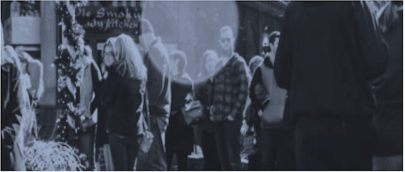Strengthening Local News Could Combat Polarization
The decline of local reporting has helped fuel polarization, misinformation and the growing tendency for Americans to demonize each other. If we have any hope of addressing those democracy-crushing problems, we have to dramatically strengthen local news.
In addition to the watchdog function, local news — of a different sort — has a community cohesion role. Obituaries, high school sports, school board meetings, the new economic development plan, the amateur theater production, a couple’s 50th wedding anniversary — these types of stories teach neighbors about each other, provide basic information on community problems and create a sense of shared interest.
The decline of local news affects how we interact with each other. When newspapers closed down in Seattle and Denver in 2008 and 2009, scholars found that residents were less likely to participate in communal activities such as the PTA, a neighborhood watch or a civic organization such as American Legion or Lions Club. Civic engagement in Denver dropped approximately 30% between 2008 and 2009.
In another study, the Pew Research Center found that 59% of those who followed local news closely had a strong sense of “community attachment” compared to 27% among those who didn’t follow local news. People who closely followed local news were far more likely to know their neighbors’ names.
The problem is not just that they know less about their town, it’s that they slide toward “knowing” a bit too much about their country. The vacuum created by the decline of local news has been filled in large part by national news. One astonishing study of 16,000 stories in local newspapers found that only 17% were about local civic issues. And those who stopped reading the paper have likely turned to cable TV.
This matters because national news is more likely to heighten our us-vs.-them mindset. In fact, professors Joshua Darr, Johanna Dunaway and Matthew Hitt have noticed that when local news availability declined, voters became more partisan — the proof being that they were less likely to split their tickets on election day. So they asked: Could strengthening local content reverse the trend? Luckily, he came across a “natural experiment” that could help them find out. The newspaper in Palm Springs, California, The Desert Sun, decided to purge its opinion pages of any national pieces for one month. That didn’t eliminate controversy. Far from it. Residents fought over a variety of issues, especially whether a new downtown arena would clog traffic and harm the Native American tribe on whose land it was.
But the battle lines were not Democrat vs. Republican, and that turned out to matter. They surveyed readers in Palm Springs and then residents of a comparable town, Ventura, where the national pundits dominated the editorial page. The result: High-information consumers in Palm Springs were less polarized compared to the nationally focused folks in Ventura. For instance, they were less likely to object to their child marrying someone of the other political party!
The advantage of local conflict is that it helpfully messes with our sense of tribal identity. Each person has several identities. You might be a Fox News viewer and a member of a church and a member of a labor union. When your ideological and partisan identities are fully aligned — all the people from all your worlds are on the same side politically — you are more likely to get emotional about it all. The walls of your bubble grow thicker. But on a local matter, an MSNBC watcher by night may find that her closest ally by day in the don’t-build-a-playground-near-the-prison fight might be a Fox News watcher. Mind blown, or at least opened.
Also, it’s usually harder to caricature someone as satanic if you’re hitching a ride into town with him. You may still think he’s an idiot, but you might be less likely to think he’s a pedophile Communist.
The local news crisis probably fuels rage for another reason: People who are less informed about their communities often feel more powerless and alienated. That same Pew Research Center study found that 52% of those who skip local news say, “People like me don’t have any say about what the government does.” Local news junkies were more upbeat; only 38% felt that way. What’s more, while only 31% of the less-informed group said they know how to “make a difference,” 65% of the local-news-heavy consumers felt empowered.
Perhaps this partly helps explain the sense of anger often seen among rural Americas. They have less local news — and don’t see themselves in their own media. Only 41% of those in rural areas said the local media mostly covered their communities; by contrast, 62% of urbanites said the local news had them covered. It’s likely that the decline of local news has harmed conservative residents as much if not more than progressives. Since some 93% of the counties in the U.S. that have no news sources were small towns (under 50,000 population), it’s not surprising that 74% voted for Trump.
The collapse of local news may even exacerbate the spread of misinformation. People are more likely to get their information from Next Door or social media sites, which are full of both truths and falsehoods, competing with each other based on equal terms. When the conservative town of Ogdensburg, New York, lost its paper for two years recently, leaders there rallied to revive it. Republican leader James E. Reagen of St. Lawrence County suggested that misinformation spread more rapidly when the Ogdensburg paper shut down. “Once the Journal closed down so many people were turning to social media, to Facebook, anonymous blogs where people could make whatever accusations and allegations they wanted to without identifying who they were,” he said in a forum held by Editor & Publisher. “There is no one to sort out the truth from the fiction.”
These negative forces feed on each other. Polarization — which we know is exacerbated by the decline of local news — also makes misinformation worse. If we start off inclined to think the worst of our opponents, we’re also more likely to believe crazy misinformation, and click retweet or forward.
Conversely, stories about people in the community help build trust and cohesion. When the Ogdensburg Record shut down, the head of the chamber of commerce bemoaned, “It’s where we get our personal stories. It’s where we get our announcements for weddings and births and obituaries. It’s where we sing the praises for student of the month or for their sports activities they’re involved in.”
Finally, having community news enables a town to better solve its problems. Sitting somewhere in between investigative reporting and human interest stories are the regular stories about civically important issues, told accurately and regularly. In writing about Salinas’s zombie paper, the Los Angeles Times noted, “When brown water overflowed the banks of the Salinas River in January, flooding thousands of acres and throwing an untold number of farmworkers out of jobs, the leading newspaper in this agricultural mecca did not cover the story. Candidates in the November race for mayor also went absent from the pages of the 152-year-old news outlet.”
Scholars Danny Hayes and Jennifer Lawless studied thousands of local news articles around the country and came to this astonishing conclusion, “One out of every three stories written about school boards in 2003 had disappeared by 2017,” they reported in “News Hole.” The trend was more alarming in small outlets. “Among those with less than 15,000 circulation, the average reduction in schools’ coverage was 56%.”
Americans in these communities have less information to guide their decisions in local elections. “In Boise, Idaho, for example, as mayoral coverage in the Idaho Statesman fell from 7.7% (2001) to 3.5% (2011) of the news hole, mayoral turnout declined from 24.8% to 11.4% Remarkably that’s a virtually identical 54% drop in both,” according to Hayes and Lawless.
Finally, good local news organizations profile the actual solutions — providing concrete ways to improve communities and also a sense of optimism about problems being solvable. A study by the Institute for Applied Positive Research found that when Detroit residents read local news articles about successful mentoring programs, 15% reported being more confident they could solve problems and 10% said they felt more connected to their communities.
The good news is that unlike some of the other causes of extremism/ misinformation/polarization/demonization, this one has a relatively simple solution: We need about 25,000 more local reporters. Yes, we should do other things to help restore democracy — ranked choice voting, gerrymandering reform, etc. But any democracy reform effort that doesn’t include an effort to sustain 25,000 more local reporters just isn’t being serious.
*Note: Adapted from the piece “How high school sports coverage can save democracy” published in Poynter.org on June 5, 2023.




